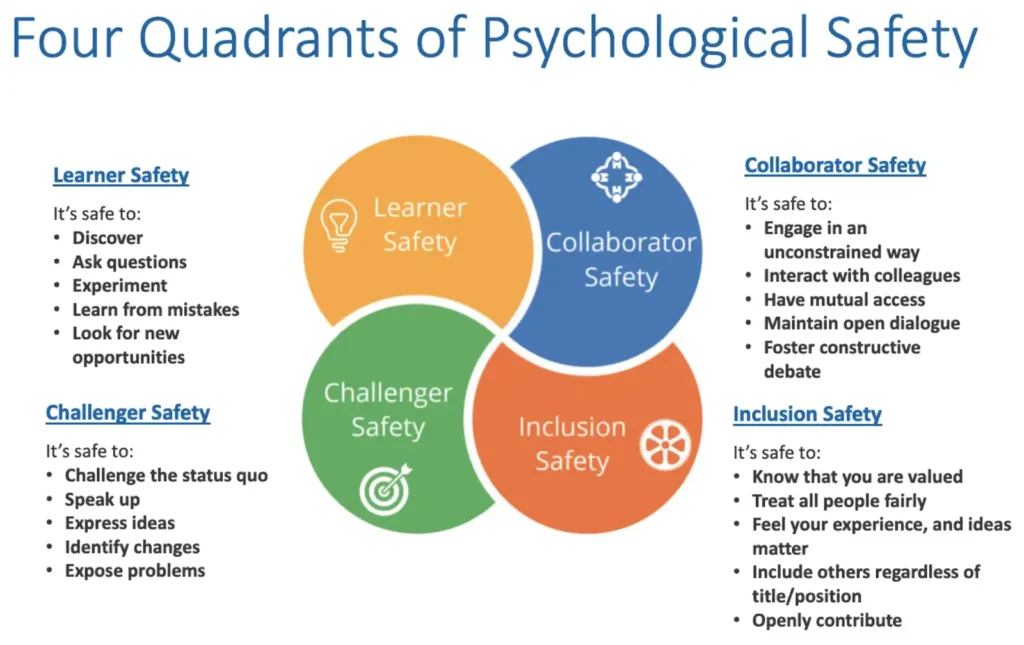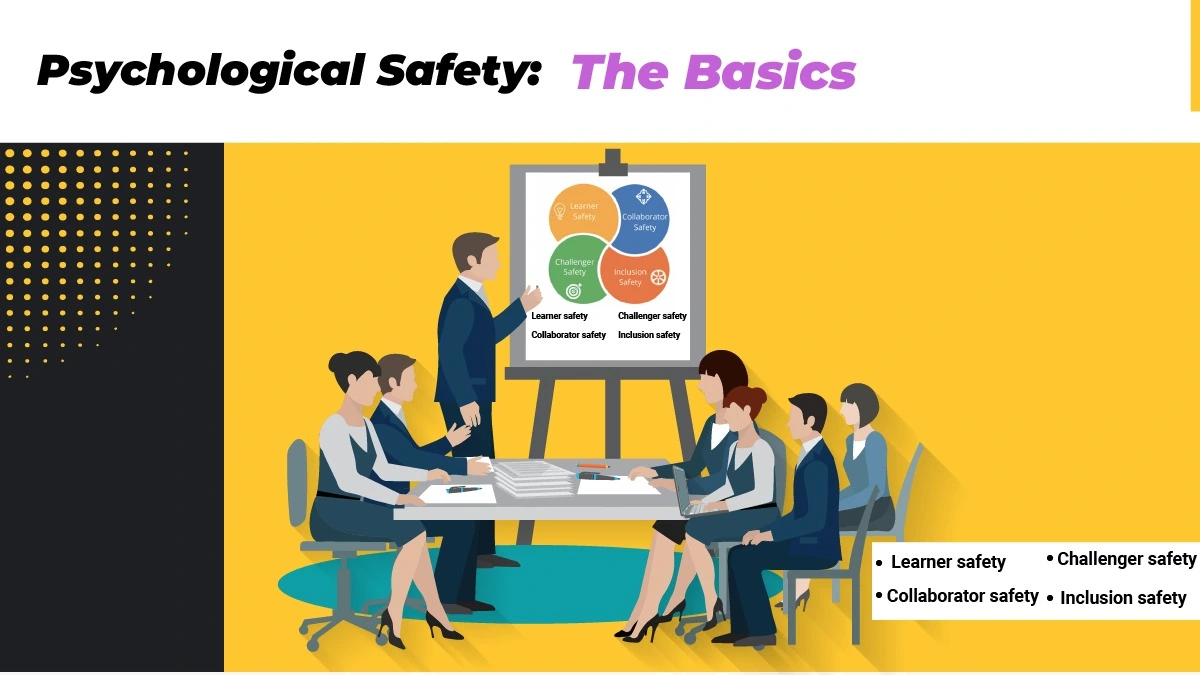According to Dr. Amy Edmondson (1999), psychological safety is a shared belief that the team is safe for interpersonal risk taking. To break it down for ease of understanding, it is a belief in your colleagues and leaders that
- one would be heard in a discussion,
- the perspective one has to offer would be valued
- one will not be interrupted while talking
- and that one would not feel afraid when asking a question or sharing an observation that may not conform or align with the dominant discourse of the group
It is a safety net, one that provides relief in the face of the anxieties one might experience when speaking up, challenging the status quo or even contributing a risky idea that might be on the wilder side of things.

There are four stages of psychological safety:
- Inclusion safety. Where one feels safe to be oneself, feel valued and accepted for who they are and that their opinions matter and are included regardless of title and position.
- Learner safety is when one feels safe to exchange in the learning process by asking questions, giving and receiving feedback, experimenting, making mistakes and looking for new opportunities.
- Contributor / Collaborator Safety is when one feels safe to use one’s skills and abilities to make a meaningful contribution, engage in an unconstrained way, maintain open dialogue and foster constructive debate and have mutual access to people and resources.
- Challenger Safety is where one feels safe to speak up and challenge the status quo when there’s an opportunity to change or improve, express ideas, identify changes and expose problems.
How can organizations use Psychological Safety?
Psychological safety has been used by organizations, like Google, in service of learning more about their employees. Google had conducted a study, called Project Aristotle, where they studied group dynamics and what makes a team efficient. The study confirmed that psychological safety was the top factor in bringing people together to work towards a common goal. When organizations can affirm the curiosity as well as the (healthy) rebellion that employees might bring to the table, it can foster a lively work environment rife with possibilities.
Inclusive leaders are mindful of their nonverbal and demonstrative behaviours while interacting with team members – asking for each person’s opinion, urging people to bring their unique perspective and not encourage groupthink, applauding those challenging status quo, recognizing new and wild ideas etc. All these are markers of a psychologically safe space at the workplace and focus on growth as an organization.
What does research say about Psychological Safety at the workplace?
One of the biggest takeaways from our research of psychological safety is that employees must feel a sense of belonging. This is a difficult task because group dynamics usually dictates whether an employee feels welcome at work or not. One can’t corral a group of people and demand that they make everyone feel at home, creating catalysts for such an environment begins with a top-down approach and must be a dedicated decision with appropriate resources allocated in service of creating a psychologically safe culture.
What are some recommendations to creating a Psychologically Safe workplace?
Organizations can create psychological safety by doing the following:
- Make Psychological safety an explicit priority – This shows that there is a commitment to upholding psychological safety and that employees are valued
- Lead by example – Leaders of an organization must take a top-down approach for a psychologically safe workplace.
- Embrace vulnerability – When we are leading the charge in being vulnerable, we are exhibiting to folx that the group or team or organization is safe for risk-taking for showing up authentically etc.
- Foster candid conversation – This means asking questions that are open-ended. Valuing trust and being a confidant for your employees.
- Facilitate everyone speaking up – Making space at the table for everyone to join in and ensuring each person contributes.
- Practice genuine curiosity – Met with a challenge? Making sure to meet it with curiosity rather than judgement can take the pressure from having to problem solve all the time.
- Recognize courageous acts – Especially when it comes to being vulnerable. Whether it is being authentic at work or bringing up a new idea or sharing doubts about the current one.
- Establish norms for how failure is handled – Failure is an integral part of growth. Failure gives us an opportunity to learn something new. Meeting failure with empathy can be the difference between a new innovation and an old mechanism.
- Promote respect – Respect is the foundation upon which trust is built. Respect should be afforded to everyone regardless of position or stature in the company.
- Create space for new ideas (even wild ones – Google, Apple and Facebook all started as wild ideas. Intentionally making space for wild new ideas could create fertile ground for growth within the organization.
- Embrace productive conflict – Conflict is a necessary part of sharpening our senses and breaking out of the comfort zones one might find ourselves in. Conflict brings about an iron sharpens iron philosophy that is great for business.
- Hold retrospectives – Debriefing after projects and having a structured space where employees can assess what worked and what didn’t; this can lead to a more successful project in the future.
- Empower from a place of privilege – Check and leverage the privilege one might hold so that your employees can feel empowered to make trusted decisions that will help the organization grow.
Psychological safety is a complex state of being. It requires patience and vulnerability along with the insight to be able to anticipate employee needs. But the rewards are great and the benefits multi-fold. It leads to higher retention, more innovation, collaboration, new skills being utilized and of course, employee satisfaction which leads to higher productivity. Our hope is to kindle the flames of psychological safety, so that the future of your organization shines bright and stable.
Written by Sanjla Perumal. Reviewed by Samriti Makkar-Midha.
 Cart is empty
Cart is empty 

